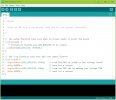Douglas McLay
Registered
Hi everyone, I'm new here so please be gentle with me 
Ive just got my railway running, and am now building up my fleet of radio controlled battery powered locos. The first ones I got were cheap toys, but they didnt last long!! So now Im converting better quality pre loved (!) track powered locos to radio control.. So far Ive converted Bachmann 4 6 0 chassis with one of my toy bodies fitted and a Piko mainline BoBo diesel using Arduinos and H Bridges as ESCs. They worked pretty well once I'd fine tuned the programme, but I have been unable to fathom out how to make the directional lights work.
My Piko diesel had headlights built in, which on track power lit up depending on direction. These were wired up to the motors, so in my niavity I just left them like that when I fed the motor from the ESC. But although the forward lED lit up, the rear one flickered brightly too. When the loco is running on high throttle levels its difficult to see which end is the brighter........
I am thinking that this must be some effect of the PWM voltage wave pattern on the IEDs, but its beyond me to work out why that is, and therefore how to cure it. Anyone got any ideas, or experienced something similar?
The only circuitry info I have from Piko is in the owners manual, and it is a bit schematic. It looks as if the three headlights at each end are fed in parallel from the motor, with each LED having its own series resistor.
The only
Ive just got my railway running, and am now building up my fleet of radio controlled battery powered locos. The first ones I got were cheap toys, but they didnt last long!! So now Im converting better quality pre loved (!) track powered locos to radio control.. So far Ive converted Bachmann 4 6 0 chassis with one of my toy bodies fitted and a Piko mainline BoBo diesel using Arduinos and H Bridges as ESCs. They worked pretty well once I'd fine tuned the programme, but I have been unable to fathom out how to make the directional lights work.
My Piko diesel had headlights built in, which on track power lit up depending on direction. These were wired up to the motors, so in my niavity I just left them like that when I fed the motor from the ESC. But although the forward lED lit up, the rear one flickered brightly too. When the loco is running on high throttle levels its difficult to see which end is the brighter........
I am thinking that this must be some effect of the PWM voltage wave pattern on the IEDs, but its beyond me to work out why that is, and therefore how to cure it. Anyone got any ideas, or experienced something similar?
The only circuitry info I have from Piko is in the owners manual, and it is a bit schematic. It looks as if the three headlights at each end are fed in parallel from the motor, with each LED having its own series resistor.
The only
Last edited:


